The Importance of Kitchen Design in Modern Homes
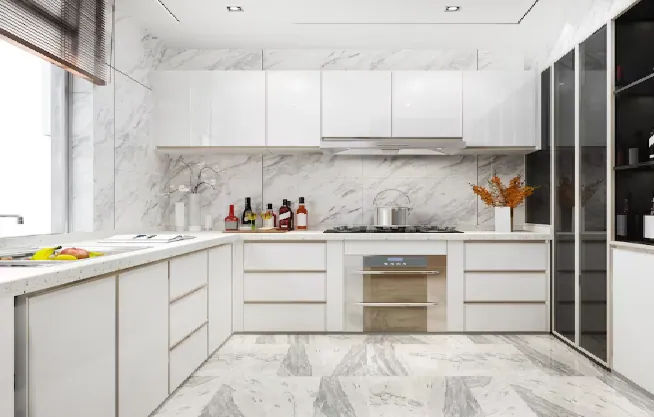
In today's homes, the kitchen is much more than just a place to cook meals. It has become the heart of the home, a space where families gather to share meals, entertain guests, and create memories. A well-designed kitchen not only enhances the functionality of the space but also adds to the overall aesthetic appeal of the home. Modern kitchen design focuses on creating a balance between practicality and style, making the kitchen a comfortable and inviting place for everyone.
Global Trends in Kitchen Designs
Around the world, kitchen design trends are constantly evolving, influenced by advancements in technology, changing lifestyles, and new materials. Some of the key global trends include open floor plans that merge the kitchen with living areas, minimalist designs with clean lines and uncluttered spaces, and the use of sustainable and eco-friendly materials. Smart kitchens equipped with the latest technology, such as touchless faucets, smart refrigerators, and integrated cooking appliances, are also gaining popularity. These trends are making their way into homes everywhere, including Pakistan, bringing with them fresh ideas and innovative solutions.
Influence of Global Trends in Pakistan
In Pakistan, the influence of these global trends is evident in the way modern kitchens are being designed. Homeowners are increasingly looking for stylish yet practical kitchen designs that suit their specific needs. The fusion of traditional Pakistani elements with modern design concepts is creating unique and personalized kitchens that reflect individual tastes and cultural heritage.
Purpose of the Post
This post aims to showcase the latest modern kitchen design trends for 2024, specifically tailored to the Pakistani context. Whether you are renovating your existing kitchen or planning a new one, this guide will provide you with inspiration and practical ideas to create a beautiful and functional kitchen that meets your needs. From contemporary minimalist designs to a blend of traditional and modern styles, discover the possibilities for your kitchen in the coming year.
The Evolution of Kitchen Designs in Pakistan
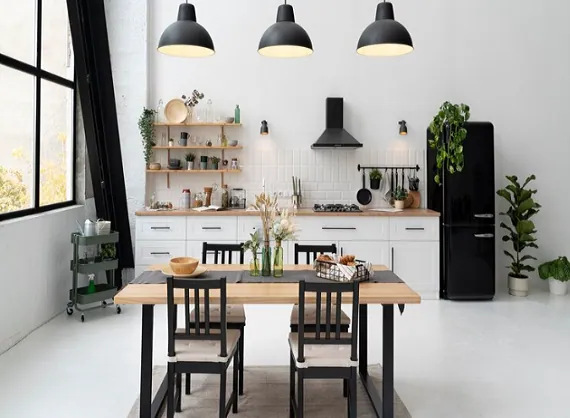
Historical Perspective on Traditional Pakistani Kitchens
Traditionally, kitchens in Pakistan were simple and functional spaces. They were usually separate from the main living areas and were designed primarily for cooking and food preparation. In rural areas, kitchens often featured wood-fired stoves and clay ovens, known as "tandoors," which are still common today. The kitchen was a place where the whole family would gather, with women typically taking the lead in cooking elaborate meals. Storage solutions were basic, with clay pots and metal containers used to store grains and spices.
Transition to Modern Kitchen Concepts
Over the years, kitchen designs in Pakistan have undergone significant changes. As urbanization increased and lifestyles became more modern, the need for efficient and stylish kitchen spaces grew. The concept of the open kitchen, integrated with the dining and living areas, started gaining popularity. This shift reflected a move towards more social and inclusive spaces where families and guests could interact while meals were being prepared.
Modern kitchens in Pakistan now feature sleek cabinetry, advanced appliances, and contemporary materials like granite, quartz, and stainless steel. The focus has shifted to creating spaces that are not only functional but also aesthetically pleasing. Ergonomic designs, with ample storage and workspace, are now a priority. Modular kitchens, which offer customizable layouts and easy installation, have become particularly popular.
Influence of Cultural and Regional Factors on Kitchen Design
Cultural and regional factors continue to play a significant role in the design of Pakistani kitchens. For instance, the traditional "desi" cooking style, which often involves frying and grilling, requires efficient ventilation systems to manage smoke and odors. Regional preferences also influence color schemes and material choices. For example, in the northern regions, kitchens may incorporate wood and earthy tones to create a warm and cozy atmosphere, while in the southern regions, brighter colors and more airy designs might be preferred.
The blend of traditional and modern elements is a hallmark of contemporary Pakistani kitchen design. Homeowners are increasingly opting for kitchens that honor their cultural heritage while embracing modern functionality and style. This evolution reflects the dynamic nature of Pakistani society, where tradition and modernity coexist harmoniously.
Key Elements of Modern Kitchen Designs
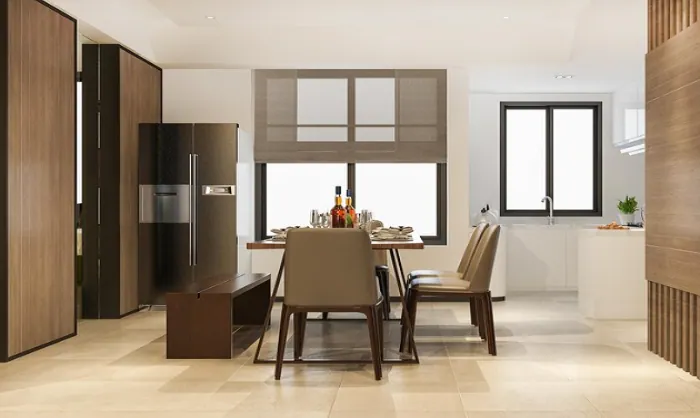
Open Floor Plans
One of the standout features of modern kitchen design is the open floor plan. This design removes walls and barriers between the kitchen and other living spaces, creating a more fluid and spacious environment. Open floor plans encourage interaction and communication among family members and guests, making the kitchen a central hub of the home. In Pakistan, open kitchens are becoming more popular, especially in urban homes where space is often limited. This design not only maximizes available space but also enhances the overall aesthetic and functionality of the home.
Minimalist Aesthetics
Minimalist aesthetics are a defining characteristic of modern kitchens. This style emphasizes simplicity, clean lines, and a clutter-free environment. In a minimalist kitchen, every element serves a purpose, and unnecessary decorations are avoided. The color palette is typically neutral, featuring shades of white, gray, and black. Sleek cabinetry, built-in appliances, and streamlined countertops contribute to a neat and orderly look. This minimalist approach is ideal for Pakistani homes aiming to create a modern, sophisticated kitchen that is easy to maintain and visually appealing.
Integration of Technology and Smart Appliances
Modern kitchens often feature the latest technology and smart appliances, making cooking and kitchen management more efficient and enjoyable. Examples include smart refrigerators with touchscreens, ovens that can be controlled via smartphone apps, and automated coffee makers. In Pakistan, the adoption of smart appliances is on the rise as homeowners seek to enhance convenience and efficiency in their kitchens. These technologies not only save time but also offer features like energy savings and improved functionality.
Sustainable and Eco-Friendly Materials
Sustainability is a key consideration in modern kitchen design. The use of eco-friendly materials and energy-efficient appliances helps reduce the environmental impact of the kitchen. Popular choices for cabinets, flooring, and countertops include bamboo, recycled wood, and low-VOC (volatile organic compounds) paints. Energy-efficient lighting and appliances also play a crucial role in creating a sustainable kitchen. In Pakistan, there is growing awareness of environmental issues, and many homeowners are choosing to incorporate sustainable practices into their kitchen designs. This not only benefits the environment but also creates a healthier living space for families.
Ergonomic and Functional Layouts
Ergonomic and functional layouts are essential elements of modern kitchen design. These layouts prioritize ease of use and accessibility, ensuring that all kitchen tasks can be performed efficiently. This includes designing workspaces that reduce strain and make movement within the kitchen comfortable. Features such as adjustable countertops, pull-out shelves, and strategically placed appliances contribute to an ergonomic design. In Pakistani kitchens, where traditional cooking methods are still prevalent, ergonomic layouts help in blending modern conveniences with traditional practices, making the kitchen both functional and user-friendly.
Popular Modern Kitchen Styles in Pakistan 2024
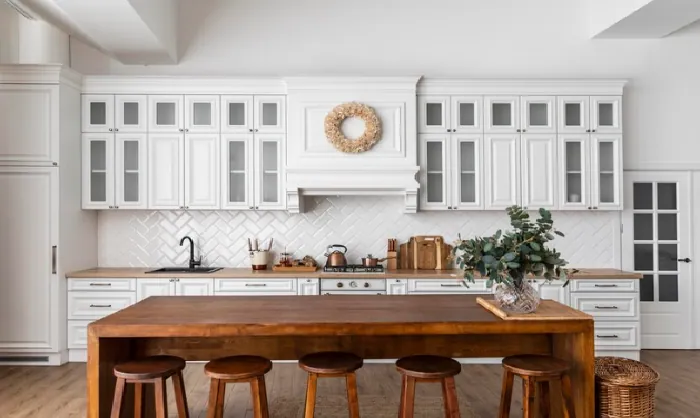
Contemporary Minimalist
Features: Clean Lines, Neutral Color Palettes, Sleek Surfaces
The contemporary minimalist kitchen style is characterized by its simplicity and elegance. This design focuses on clean lines and a lack of clutter, creating a serene and orderly space. Neutral color palettes are a hallmark of this style, with shades of white, gray, and black being predominant. These colors provide a timeless backdrop that can be easily complemented with subtle accents and decor. Sleek surfaces, such as glossy countertops, smooth cabinetry, and modern stainless steel appliances, enhance the minimalist look, making the kitchen appear more spacious and refined.
Benefits: Easy Maintenance, Spacious Feel
One of the main benefits of a contemporary minimalist kitchen is its easy maintenance. The design's simplicity means there are fewer details and decorations to clean, making daily upkeep straightforward and less time-consuming. The use of smooth and flat surfaces also reduces the accumulation of dust and grime, contributing to a cleaner and more hygienic environment.
Another significant advantage is the spacious feel that this style imparts. The open and uncluttered layout, combined with light colors and reflective surfaces, creates an illusion of more space. This is particularly beneficial in smaller homes or apartments in Pakistan, where maximizing available space is often a priority. The minimalist approach ensures that the kitchen remains functional and efficient, without feeling cramped or overcrowded.
Examples: Local Adaptations and Inspirational Designs
In Pakistan, contemporary minimalist kitchens can be adapted to suit local preferences and needs. For instance, while maintaining clean lines and neutral colors, homeowners might incorporate traditional elements like intricately designed backsplashes or locally crafted cabinetry to add a touch of cultural heritage. Inspirational designs can be found in various Pakistani interior design magazines and online platforms, showcasing how the minimalist aesthetic can be personalized.
One popular adaptation is the use of marble or granite countertops, which add a luxurious feel while staying true to the minimalist ethos. Another example is integrating modern, built-in appliances that blend seamlessly with the cabinetry, preserving the sleek and unobtrusive look.
Popular Modern Kitchen Styles in Pakistan 2024
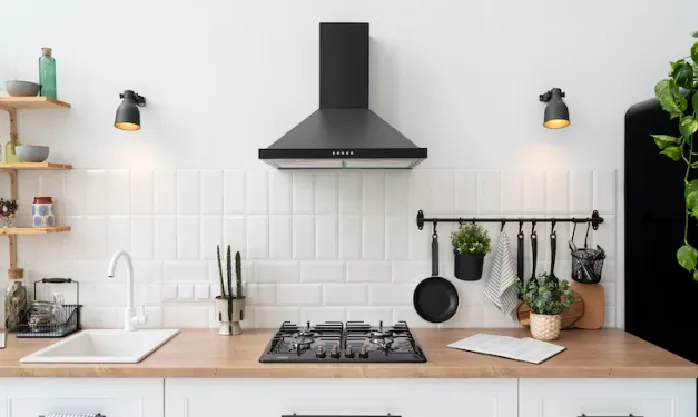
Industrial Chic
Features: Exposed Brick, Metal Accents, Reclaimed Wood
The industrial chic kitchen style is inspired by the look of old factories and industrial spaces, which is both rugged and stylish. Key features of this style include exposed brick walls, metal accents, and reclaimed wood elements. The exposed brick gives the kitchen a raw and authentic feel, adding texture and character. Metal accents, such as stainless steel appliances, metal shelving, and iron light fixtures, provide a sleek and modern contrast to the rustic elements. Reclaimed wood is often used for countertops, cabinetry, and flooring, adding warmth and a sense of history to the space.
Benefits: Durable, Trendy, and Stylish
One of the main benefits of the industrial chic kitchen is its durability. The materials used, like metal and reclaimed wood, are sturdy and long-lasting, able to withstand the rigors of daily use. This makes it a practical choice for busy households.
The industrial chic style is also very trendy and stylish. It combines the old and the new, creating a unique and modern look that stands out. This style is particularly popular among younger homeowners and those looking to give their kitchen a contemporary edge. The mix of materials and textures creates a visually interesting space that is both functional and aesthetically pleasing.
Examples: Trendy Loft-Style Kitchens in Urban Pakistani Homes
In Pakistan, the industrial chic kitchen style is becoming popular in urban areas, especially in loft-style apartments and modern homes. For instance, a trendy loft-style kitchen in Karachi or Lahore might feature exposed brick walls paired with sleek metal cabinets and reclaimed wood countertops. These elements create a dynamic and stylish space that reflects the homeowner’s taste and personality.
Local adaptations of the industrial chic style might include the use of locally sourced reclaimed wood or metal fixtures crafted by local artisans. These touches add a unique, personal element to the kitchen while supporting local craftsmanship.
Popular Modern Kitchen Styles in Pakistan 2024
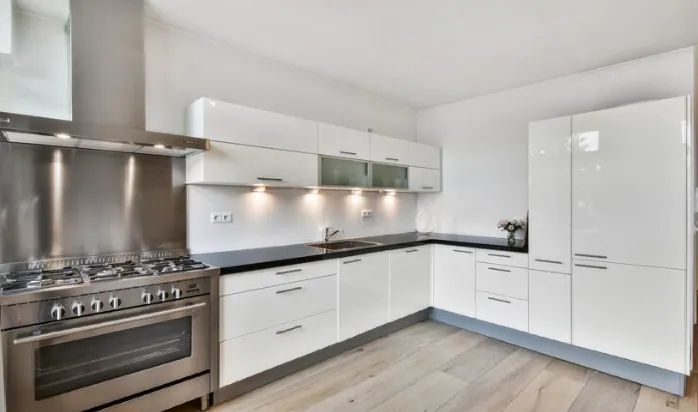
Scandinavian Influence
Features: Light Colors, Natural Materials, Simplicity
The Scandinavian influence in kitchen design is characterized by its clean, minimalist approach that emphasizes functionality and simplicity. Key features of this style include light colors, natural materials, and a focus on simple, uncluttered spaces. Light colors, such as white, light gray, and soft pastels, dominate the color palette, creating a bright and welcoming atmosphere. Natural materials like wood and stone are used extensively, adding warmth and texture to the space. This design style prioritizes simplicity, with sleek lines and minimal decorative elements, ensuring that the kitchen remains functional and easy to maintain.
Benefits: Bright and Airy Spaces, Cozy and Functional
One of the primary benefits of the Scandinavian kitchen style is the creation of bright and airy spaces. The use of light colors and natural light makes the kitchen feel larger and more open, which is particularly beneficial in smaller homes. This bright environment can enhance mood and make the kitchen a more pleasant place to spend time.
Another benefit is the cozy and functional nature of Scandinavian kitchens. Despite their simplicity, these kitchens are designed to be highly practical, with well-thought-out storage solutions and efficient use of space. The natural materials and warm colors also contribute to a cozy, inviting atmosphere that makes the kitchen feel like the heart of the home.
Examples: Adaptations to Fit Pakistani Lifestyles and Climate
In Pakistan, the Scandinavian kitchen style can be adapted to suit local lifestyles and climate. For instance, while maintaining the characteristic light colors and simplicity, homeowners might incorporate local materials like marble or granite for countertops, which are both durable and stylish. Wood elements can be sourced locally to ensure the kitchen feels warm and connected to its environment.
To adapt to the warmer climate, ventilation and cooling solutions can be integrated into the design. Light-colored cabinetry and countertops can help reflect heat, keeping the kitchen cooler. Additionally, incorporating indoor plants can add a touch of greenery, enhancing the natural feel and improving air quality.
Popular Modern Kitchen Styles in Pakistan 2024
Fusion of Traditional and Modern
Features: Incorporation of Traditional Pakistani Elements with Modern Design
The fusion of traditional and modern styles in kitchen design blends elements of Pakistani heritage with contemporary aesthetics. This style combines the rich cultural heritage of Pakistan with the sleek and functional aspects of modern design. Key features include the incorporation of traditional Pakistani elements such as intricate woodwork, colorful tiles, and handcrafted details, alongside modern design elements like clean lines, minimalist accents, and innovative technology.
Benefits: Cultural Resonance, Unique Aesthetics
One of the primary benefits of the fusion of traditional and modern styles is its cultural resonance. By incorporating traditional Pakistani elements into the kitchen design, homeowners can create spaces that reflect their cultural heritage and personal identity. This adds a sense of authenticity and connection to the space, making the kitchen a unique and meaningful part of the home.
Another benefit is the creation of unique aesthetics. The blending of traditional and modern elements results in kitchens that are visually striking and distinctive. Whether it's combining carved wood cabinets with sleek stainless steel appliances or incorporating colorful tiles into a minimalist backsplash, the fusion of styles creates kitchens that stand out and make a statement.
Examples: Blending Carved Wood Cabinets with Modern Appliances
In Pakistan, examples of the fusion of traditional and modern kitchen designs can be seen in the blending of carved wood cabinets with modern appliances. For instance, homeowners might opt for intricately carved wooden cabinets inspired by traditional Pakistani craftsmanship, paired with state-of-the-art appliances like smart refrigerators and induction cooktops. This combination creates a harmonious balance between old and new, adding warmth and character to the kitchen while still providing the convenience and functionality of modern technology.
Other examples include incorporating traditional Pakistani patterns into modern tile designs, or using handcrafted pottery and textiles as decorative accents. These elements add depth and personality to the kitchen, creating spaces that are both culturally rich and visually captivating.
Essential Components of a Modern Kitchen
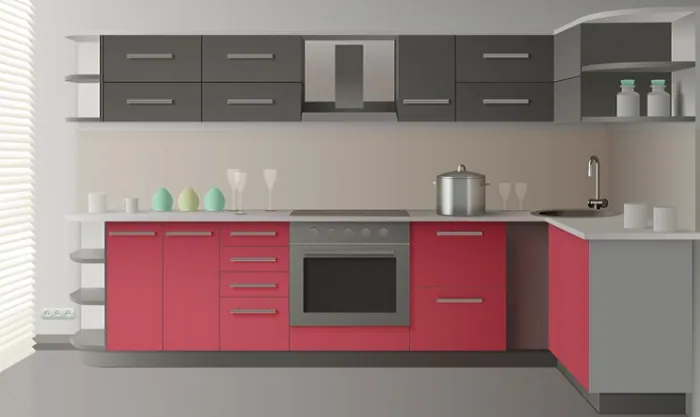
Cabinets and Storage Solutions
Modern Cabinet Designs and Finishes
Modern kitchen cabinets come in a variety of designs and finishes that contribute to the overall aesthetic and functionality of the space. Sleek, flat-panel cabinets with minimalist hardware are a popular choice for modern kitchens, providing a clean and streamlined look. High-gloss finishes in white or neutral tones are often used to create a bright and airy atmosphere, while matte finishes in darker colors add a touch of sophistication.
In addition to standard cabinetry, modern kitchens may feature specialized storage solutions such as pull-out pantry shelves, deep drawers with dividers for pots and pans, and vertical storage racks for trays and cutting boards. These innovative storage solutions help maximize space and keep the kitchen organized and clutter-free.
Innovative Storage Solutions to Maximize Space
One of the hallmarks of modern kitchen design is its focus on maximizing space and efficiency. Innovative storage solutions play a crucial role in achieving this goal. For example, corner cabinets with rotating shelves make it easy to access items stored in the back corners, while pull-out spice racks and utensil organizers keep essential items within reach. Tall, narrow cabinets known as "pantry towers" provide vertical storage for canned goods and dry ingredients, freeing up valuable countertop and cabinet space.
Another popular storage solution is the use of multi-functional furniture pieces, such as kitchen islands with built-in storage or banquettes with hidden compartments. These versatile pieces not only provide additional storage but also serve as focal points in the kitchen, adding both style and functionality.
In modern kitchens, maximizing storage space is essential, especially in smaller homes or apartments where space is limited. By incorporating innovative storage solutions like pull-out drawers, vertical racks, and multi-functional furniture, homeowners can create efficient and organized kitchens that meet their needs and lifestyle.
Essential Components of a Modern Kitchen
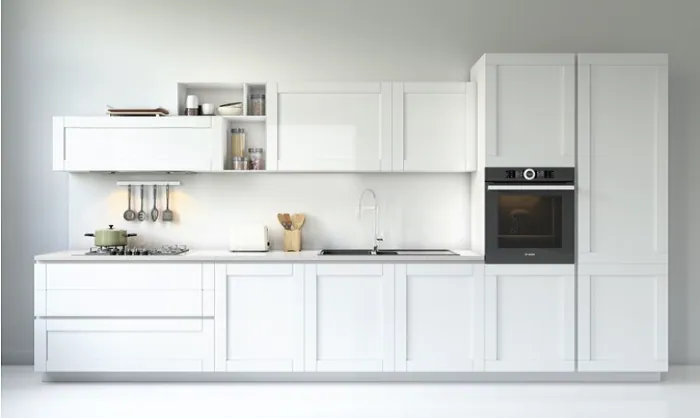
Countertops and Surfaces
Popular Materials: Quartz, Granite, Marble, and Engineered Stone
Modern kitchens often feature countertops and surfaces made from a variety of materials, each with its own unique characteristics and appeal.
Quartz: Quartz countertops are a popular choice for modern kitchens due to their durability, low maintenance, and wide range of colors and patterns. Made from crushed quartz mixed with resin, these countertops are non-porous, resistant to stains, and easy to clean. They also offer consistency in color and pattern, making them a versatile option for contemporary kitchen designs.
Granite: Granite countertops are prized for their natural beauty, durability, and heat resistance. Quarried from solid stone slabs, granite countertops add elegance and sophistication to modern kitchens. While granite requires periodic sealing to prevent staining, it offers unmatched durability and can withstand heat, scratches, and chips.
Marble: Marble countertops are renowned for their timeless beauty and luxury appeal. Known for its unique veining and patterns, marble adds a touch of elegance to any kitchen. However, marble is softer and more porous than granite or quartz, making it susceptible to scratching, staining, and etching from acidic substances. Regular sealing and maintenance are required to preserve its beauty.
Engineered Stone: Engineered stone countertops, such as those made from brands like Caesarstone or Silestone, are composed of crushed quartz or granite mixed with resin. These countertops offer the beauty of natural stone with added durability and consistency. Engineered stone is non-porous, making it resistant to stains, scratches, and bacteria growth. It also comes in a wide range of colors and patterns to suit various kitchen designs.
Pros and Cons of Each Material
- Quartz: Pros include durability, low maintenance, and a wide range of colors and patterns. Cons may include higher cost compared to other materials.
- Granite: Pros include natural beauty, durability, and heat resistance. Cons may include the need for periodic sealing and potential for variation in color and pattern.
- Marble: Pros include timeless beauty and luxury appeal. Cons may include susceptibility to scratching, staining, and etching, as well as higher maintenance requirements.
- Engineered Stone: Pros include durability, consistency, and resistance to stains and scratches. Cons may include higher cost compared to other materials and limited availability of unique patterns.
Essential Components of a Modern Kitchen
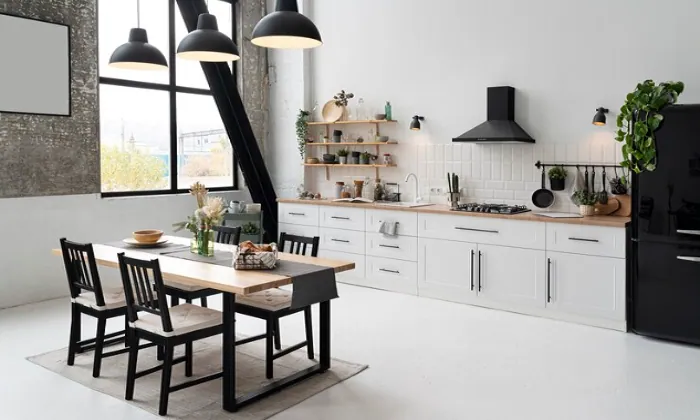
Appliances and Technology
Latest Smart Appliances Available in Pakistan
In modern kitchens, the integration of smart appliances has become increasingly prevalent, offering convenience, efficiency, and enhanced functionality to homeowners. Some of the latest smart appliances available in Pakistan include:
- Smart Refrigerators: These refrigerators feature touchscreens, Wi-Fi connectivity, and built-in cameras that allow users to remotely monitor their contents and access information such as shopping lists and recipes. Some models even offer voice control capabilities, enabling hands-free operation.
- Smart Ovens: Smart ovens are equipped with advanced features such as precision temperature control, programmable cooking modes, and compatibility with smartphone apps. Users can remotely preheat the oven, adjust cooking settings, and receive notifications when their food is ready.
- Smart Dishwashers: Smart dishwashers offer features like Wi-Fi connectivity, customizable wash cycles, and water usage tracking. Users can monitor the progress of their dishwashing cycle remotely and receive alerts when detergent or rinse aid needs to be refilled.
- Smart Cooktops: Smart cooktops feature induction technology, which offers precise temperature control and faster heating compared to traditional gas or electric cooktops. Some models also include built-in sensors that automatically adjust cooking settings based on the size and type of cookware used.
- Smart Coffee Makers: Smart coffee makers allow users to customize their coffee preferences, such as brew strength and temperature, using smartphone apps. Some models also offer built-in grinders and automatic brewing schedules for added convenience.
Integration of Technology for Convenience and Efficiency
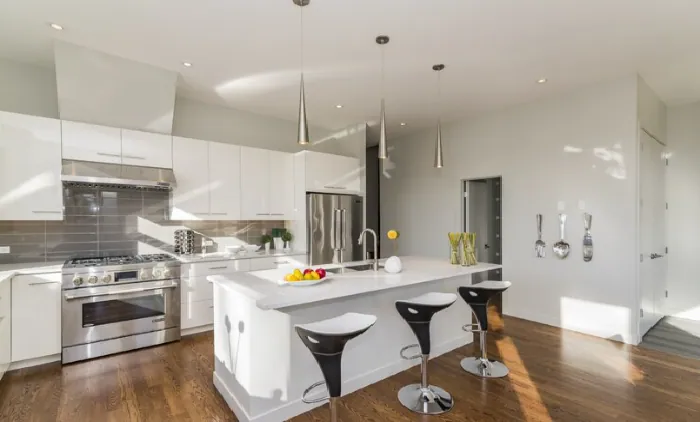
The integration of technology in modern kitchens goes beyond individual smart appliances to encompass entire kitchen ecosystems. Smart home automation systems, such as those compatible with platforms like Amazon Alexa and Google Assistant, allow users to control multiple appliances and devices with voice commands or smartphone apps.
For example, users can create custom routines that automate tasks like preheating the oven, starting the coffee maker, and adjusting the thermostat when they wake up in the morning. Motion sensors and smart lighting systems can also be integrated to improve energy efficiency and enhance safety by automatically turning lights on and off as needed.
By leveraging the latest advancements in smart home technology, modern kitchens in Pakistan are becoming more convenient, efficient, and interconnected than ever before. Whether it's simplifying meal preparation, optimizing energy usage, or enhancing overall comfort and convenience, smart appliances and technology are transforming the way we experience and interact with our kitchens.
Essential Components of a Modern Kitchen
Importance of Layered Lighting: Task, Ambient, and Accent Lighting
In modern kitchen design, layered lighting plays a crucial role in creating a functional, comfortable, and visually appealing space. Layered lighting involves the use of different types of lighting fixtures strategically placed throughout the kitchen to provide illumination for various tasks, enhance ambiance, and highlight architectural features or decorative elements.
- Task Lighting: Task lighting is essential for illuminating specific work areas in the kitchen where tasks such as food preparation, cooking, and cleaning take place. Under-cabinet lights, recessed lights, and pendant lights positioned above countertops and cooking surfaces help minimize shadows and provide focused illumination for tasks that require precision and attention to detail.
- Ambient Lighting: Ambient lighting serves as the overall illumination for the kitchen, providing a comfortable level of brightness that fills the space evenly. Ceiling-mounted fixtures such as recessed lights, flush mounts, and track lights are commonly used to provide ambient lighting. These fixtures help create a well-lit environment that enhances visibility and promotes a sense of openness and spaciousness.
- Accent Lighting: Accent lighting is used to highlight specific architectural features, decorative elements, or focal points in the kitchen, adding depth and visual interest to the space. Examples of accent lighting fixtures include wall sconces, cabinet lighting, and LED strip lights. By selectively illuminating certain areas or objects, accent lighting draws attention to design elements and creates a dynamic and inviting atmosphere.
Modern Lighting Fixtures and Trends
In modern kitchens, lighting fixtures have evolved to reflect contemporary design trends and technological advancements. Some popular modern lighting fixtures and trends include:
- LED Lighting: LED lighting has become increasingly popular in modern kitchens due to its energy efficiency, long lifespan, and versatility. LED recessed lights, strip lights, and pendant lights are commonly used to provide efficient and customizable illumination.
- Sleek and Minimalist Designs: Modern lighting fixtures often feature sleek, minimalist designs that complement the clean lines and minimalist aesthetic of contemporary kitchen designs. Flush mounts, track lights, and linear pendant lights with simple geometric shapes and clean finishes are popular choices for modern kitchens.
- Statement Lighting: Statement lighting fixtures, such as oversized pendant lights, chandeliers, and sculptural fixtures, are used to add drama and visual impact to modern kitchens. These eye-catching fixtures serve as focal points and conversation starters, adding personality and style to the space.
In conclusion, layered lighting is essential for creating a modern kitchen that is both functional and visually appealing. By incorporating task, ambient, and accent lighting, homeowners can achieve a well-balanced and versatile lighting scheme that enhances the functionality, ambiance, and aesthetics of their kitchen. With modern lighting fixtures and trends such as LED lighting, sleek designs, and statement lighting, modern kitchens in Pakistan can be transformed into stylish and inviting spaces that cater to the needs and preferences of today's homeowners.
Sustainable Kitchen Designs
Use of Eco-Friendly Materials and Energy-Efficient Appliances
Sustainable kitchen designs prioritize the use of eco-friendly materials and energy-efficient appliances to minimize environmental impact and promote sustainability. These designs aim to reduce resource consumption, minimize waste generation, and create healthier living environments for homeowners.
Tips for Creating a Sustainable Kitchen in Pakistan
- Choose Eco-Friendly Materials: Opt for sustainable materials such as bamboo, reclaimed wood, recycled glass, and recycled metal for cabinets, countertops, flooring, and backsplashes. These materials are renewable, recycled, or responsibly sourced, reducing the environmental footprint of your kitchen.
- Select Energy-Efficient Appliances: Invest in energy-efficient appliances with high Energy Star ratings to reduce energy consumption and lower utility bills. Look for appliances with advanced features such as eco-friendly refrigerants, smart sensors, and energy-saving modes that help conserve resources and minimize greenhouse gas emissions.
- Maximize Natural Light: Make the most of natural light by incorporating large windows, skylights, and glass doors in your kitchen design. Natural light not only reduces the need for artificial lighting but also creates a bright and inviting atmosphere that enhances mood and productivity.
- Optimize Ventilation: Install energy-efficient ventilation systems such as range hoods with variable-speed fans and HEPA filters to remove cooking odors, smoke, and pollutants from the air. Proper ventilation helps maintain indoor air quality, reduces respiratory problems, and promotes a healthier living environment.
- Reduce Water Usage: Install water-saving fixtures such as low-flow faucets, aerators, and dual-flush toilets to conserve water and reduce water bills. Consider harvesting rainwater for irrigation and greywater recycling systems to reuse water for non-potable purposes such as flushing toilets and watering plants.
Examples of Local Suppliers and Sustainable Design Practices
In Pakistan, several local suppliers offer eco-friendly materials and sustainable design solutions for kitchens:
- Greenovation: Greenovation offers a wide range of eco-friendly building materials, including bamboo flooring, recycled glass countertops, and sustainable wood cabinets. They also provide energy-efficient appliances and water-saving fixtures to promote sustainable living.
- Eco Wood: Eco Wood specializes in reclaimed wood products such as flooring, countertops, and furniture made from salvaged wood sourced from old buildings and furniture factories. Their reclaimed wood products not only add character and warmth to kitchens but also reduce deforestation and carbon emissions.
- Sustainable Design Practices: Local architects and designers incorporate sustainable design practices such as passive solar design, natural ventilation, and rainwater harvesting into their kitchen designs to minimize energy consumption and environmental impact. By integrating sustainable features and materials, these designers create kitchens that are both eco-friendly and aesthetically pleasing.
Customized Kitchen Designs
Importance of Tailoring Designs to Individual Needs and Preferences
Customized kitchen designs are essential for meeting the unique needs and preferences of homeowners. Every household has its own lifestyle, cooking habits, and space requirements, making it crucial to tailor the kitchen design to suit these individual factors. By customizing the kitchen layout, storage solutions, and aesthetic elements, homeowners can create a space that not only reflects their personality but also enhances functionality and efficiency.
Examples of Customized Kitchens for Different Pakistani Households
- Large Family Kitchen: For a large Pakistani family, a spacious kitchen with ample storage, multiple workstations, and durable materials is essential. Custom features such as a large kitchen island with seating, double ovens, and a walk-in pantry can accommodate the needs of a busy household. Incorporating traditional elements like carved wood cabinets or colorful tile accents adds cultural flair to the design.
- Compact Apartment Kitchen: In a compact apartment kitchen, maximizing space and efficiency is key. Customized solutions such as slim-profile appliances, pull-out pantry shelves, and multi-functional furniture help make the most of limited square footage. Light colors, reflective surfaces, and smart storage solutions create a sense of openness and brightness in the small space.
- Gourmet Chef's Kitchen: For a passionate home chef, a gourmet kitchen with high-end appliances, professional-grade equipment, and abundant counter space is essential. Custom features like a commercial-style range, pot filler faucet, and dedicated prep areas cater to the needs of serious cooking enthusiasts. Incorporating luxury materials such as marble countertops and custom cabinetry elevates the design to create a culinary haven.
Role of Professional Interior Designers in Creating Personalized Kitchens
Professional interior designers play a crucial role in creating personalized kitchens that meet the unique needs and preferences of homeowners. Designers work closely with clients to understand their lifestyle, cooking habits, and design preferences, translating these insights into customized kitchen layouts and solutions. From space planning and material selection to lighting design and color coordination, interior designers bring expertise and creativity to the process, ensuring that every aspect of the kitchen design reflects the client's vision.
By collaborating with professional designers, homeowners can benefit from expert guidance, innovative ideas, and access to exclusive resources and materials. Designers help navigate the complexities of kitchen design, from optimizing layout and functionality to creating cohesive aesthetics that harmonize with the rest of the home. With their skills and experience, interior designers transform ordinary kitchens into personalized spaces that exceed expectations and enhance daily life for Pakistani households.
Budget-Friendly Modern Kitchen Design Ideas
Cost-Effective Materials and Solutions
Creating a modern kitchen on a budget requires careful consideration of cost-effective materials and solutions that offer style and functionality without breaking the bank.
- Laminate Countertops: Laminate countertops are an affordable alternative to natural stone surfaces like granite or marble. They come in a wide range of colors and patterns, mimicking the look of expensive materials at a fraction of the cost.
- Vinyl Flooring: Vinyl flooring is a durable and budget-friendly option for kitchen floors. It is available in various designs, including wood-look and tile-look options, providing versatility and style at an affordable price point.
- Prefabricated Cabinets: Prefabricated cabinets are a cost-effective solution for kitchen cabinetry. Ready-to-assemble (RTA) cabinets are available in a variety of styles and finishes, allowing homeowners to achieve a modern look without the custom price tag.
- Painted Backsplashes: Instead of expensive tile or stone backsplashes, consider painting the walls with a high-quality, water-resistant paint. This DIY solution is budget-friendly and allows for creative expression through color choices and patterns.
DIY Tips for a Modern Kitchen Makeover
- Paint Cabinets: Give outdated cabinets a modern refresh by painting them in a fresh, contemporary color. Light neutrals like white or gray can instantly brighten up the space and create a modern aesthetic.
- Upgrade Hardware: Replace old cabinet hardware with sleek, modern handles and knobs for an instant update. Choose finishes like brushed nickel or matte black for a modern touch.
- Install Open Shelving: Remove upper cabinet doors and install open shelving for a modern, airy look. Displaying dishes, glassware, and decorative items on open shelves adds visual interest and personality to the kitchen.
- Add Lighting: Enhance the ambiance of the kitchen with modern lighting fixtures. Install pendant lights above the island or breakfast bar for task lighting, and add under-cabinet lighting for both functionality and style.
Where to Source Affordable Yet Stylish Kitchen Components in Pakistan
- Local Hardware Stores: Many local hardware stores in Pakistan offer a variety of budget-friendly kitchen components such as cabinets, countertops, and hardware.
- Online Marketplaces: Explore online marketplaces like Daraz.pk and OLX for affordable yet stylish kitchen components, including appliances, fixtures, and accessories.
- Wholesale Markets: Visit wholesale markets in major cities like Karachi, Lahore, and Islamabad for discounted prices on kitchen materials and components.
- DIY Stores: DIY stores like Homelux Pakistan offer a range of affordable kitchen solutions, including cabinet hardware, lighting fixtures, and organizational accessories.
By incorporating cost-effective materials, implementing DIY techniques, and sourcing affordable components, homeowners in Pakistan can achieve a modern kitchen design on a budget without compromising on style or functionality.
Showcase of Modern Kitchen Designs by Pakistani Designers
Profiles of Notable Pakistani Kitchen Designers
Pakistani designers are making their mark in the field of modern kitchen design, bringing innovation, creativity, and cultural influence to their projects. Here are profiles of some notable Pakistani kitchen designers:
- Ali Bakhtiar Designs: With a focus on contemporary elegance and functionality, Ali Bakhtiar Designs is known for creating modern kitchens that blend style and practicality seamlessly. Their portfolio showcases sleek cabinetry, innovative storage solutions, and luxurious finishes that cater to the needs and preferences of their clients.
- Faisal Habib Architects: Faisal Habib Architects is renowned for their minimalist approach to kitchen design, emphasizing clean lines, simplicity, and sophistication. Their modern kitchens feature sleek surfaces, monochromatic color palettes, and strategic lighting designs that create a sense of space and serenity.
- Mahwish Shoaib Interiors: Mahwish Shoaib Interiors specializes in creating personalized kitchen spaces that reflect the unique tastes and lifestyles of their clients. From contemporary chic to rustic charm, their portfolio includes a diverse range of kitchen designs that showcase creativity, versatility, and attention to detail.
Examples of Their Work and Signature Styles
- Ali Bakhtiar Designs: Ali Bakhtiar Designs' signature style is characterized by minimalist aesthetics, functional layouts, and luxurious finishes. Their projects often feature open-concept designs, high-gloss cabinetry, and integrated smart appliances, creating modern kitchens that are both stylish and practical.
- Faisal Habib Architects: Faisal Habib Architects' work is defined by its emphasis on simplicity, sophistication, and timeless elegance. Their kitchens typically feature clean lines, geometric shapes, and understated color palettes, evoking a sense of understated luxury and refinement.
- Mahwish Shoaib Interiors: Mahwish Shoaib Interiors' designs are known for their eclectic mix of styles, textures, and colors. From bold statement pieces to subtle accents, their kitchens incorporate elements of traditional Pakistani craftsmanship, contemporary design trends, and global influences, resulting in spaces that are vibrant, eclectic, and inviting.
Client Testimonials and Project Highlights
- “Working with Ali Bakhtiar Designs was a pleasure from start to finish. They listened to our needs and preferences and transformed our outdated kitchen into a modern masterpiece. The attention to detail and quality of craftsmanship exceeded our expectations.” - Sarah and Ahmed, Lahore
- “Faisal Habib Architects created the kitchen of our dreams. Their innovative design solutions and impeccable taste turned our vision into reality. We couldn't be happier with the result.” - Fatima and Ali, Karachi
- “Mahwish Shoaib Interiors brought our kitchen to life with their creative flair and personalized approach. Their ability to blend different styles and textures resulted in a space that is uniquely ours.” - Ayesha and Omar, Islamabad
Conclusion
In conclusion, modern kitchen design is paramount for enhancing functionality and aesthetics in Pakistani homes. Embracing the latest trends and customizing them to personal needs allows homeowners to create spaces that reflect their lifestyle and preferences. As Pakistan continues to evolve, the future of kitchen design holds promise, with innovation, sustainability, and cultural influences shaping the kitchens of tomorrow. By staying informed, creative, and adaptable, homeowners and designers alike can ensure that kitchens remain dynamic, functional, and beautiful spaces for generations to come.
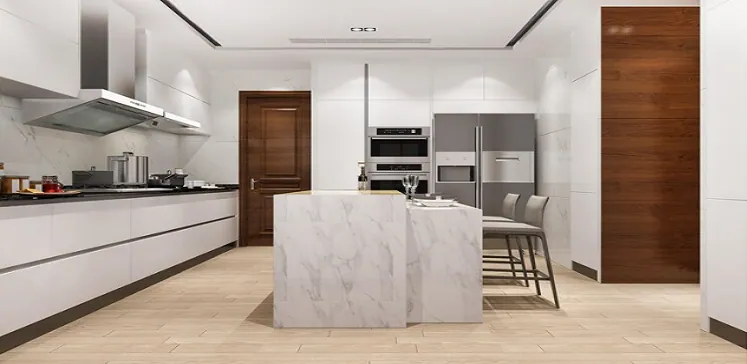
Comments